|
|
|
Sort Order |
|
|
|
Items / Page
|
|
|
|
|
|
|
| Srl | Item |
| 1 |
ID:
100961
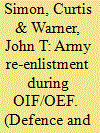

|
|
|
|
|
| Publication |
2010.
|
| Summary/Abstract |
In 2004, stretched by wartime deployments, the US Army countered declining retention by increasing re-enlistment bonuses and implementing stop-loss to prevent soldiers from separating at the end of their enlistment. We estimate the effects of bonuses, deployment, and stop-loss on re-enlistment between FY 2002 and 2006. We estimate that the baseline propensity to re-enlist fell by 20%. However, we find that deployed soldiers are more likely to re-enlist and that the estimated effects of re-enlistment bonuses are similar to those estimated in peacetime. We evaluate the reasons for our findings, and calculate the cost effectiveness of re-enlistment bonuses.
|
|
|
|
|
|
|
|
|
|
|
|
|
|
|
|
| 2 |
ID:
127828
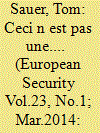

|
|
|
|
|
| Publication |
2014.
|
| Summary/Abstract |
There is hardly anybody in Belgium who publicly defends the continued deployment of US tactical nuclear weapons on Belgian territory. The longer these weapons stay, the more the existing nuclear weapons policy and by extension North Atlantic Treaty Organization itself will be regarded as illegitimate. While one should not expect massive demonstrations similar to that at the beginning of the 1980s, the pressure to protest increases. By describing the different societal and political actors in Belgium and their respective views on the possible withdrawal of US tactical nuclear weapons, this article tries to explain the gap between policymakers and citizens on this issue. The main explanatory variables are a low-profile diplomatic culture and the lack of a strong link between the anti-nuclear movement and the political parties in power, resulting in the absence of political leaders at the governmental level, who clearly speak out in favor of withdrawal.
|
|
|
|
|
|
|
|
|
|
|
|
|
|
|
|
| 3 |
ID:
160094
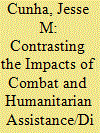

|
|
|
|
|
| Summary/Abstract |
We study the differential impacts of combat and humanitarian assistance/disaster relief (HA/DR) missions on the mental health of U.S. Marine Corps members. The deployment experiences of any individual Marine are plausibly random conditional on the observable characteristics which are used to assign Marines into units. Leveraging this exogenous variation, we compare the incidence of post-traumatic stress disorder (PTSD) and suicide deaths among Marines who deployed to either Operation Enduring Freedom/Operation Iraqi Freedom (OEF/OIF) or HA/DR missions between 2001 and 2011. We find that the hazard of PTSD is close to eight times higher among Marines returning from OEF/OIF compared to those never deployed, and just 1.33 times higher among those returning from HA/DR (and never participated in OEF/OIF). Those returning from OEF/OIF missions are 1.81 times more likely than those never deployed to die by suicide when they were still active duty, and the hazard increases to almost 3 after they have left the military. In contrast, we find no difference in the hazards of suicide death between those that deployed to only HA/DR missions and non-deployed Marines.
|
|
|
|
|
|
|
|
|
|
|
|
|
|
|
|
| 4 |
ID:
112371
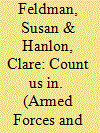

|
|
|
|
|
| Publication |
2012.
|
| Summary/Abstract |
This article reports the findings of a qualitative study that explores the linkages between female veterans' experiences in warlike, peacemaking, peacekeeping, and humanitarian operations and their perceived health support needs over the long term. It is based on the experiences of Australian female veterans who had deployed overseas. The findings suggest that a woman's emotional well-being over the long term and ability to fully reintegrate back into civilian life after deployment is diminished when there is a significant disparity between her expectations of deployment and her actual operational experiences. A major implication from these findings is that civilian health and support services should develop a better understanding of the distinctive needs of the female veteran population and develop stronger linkages with the military community so as to facilitate ongoing deployment-related support for female veterans.
|
|
|
|
|
|
|
|
|
|
|
|
|
|
|
|
| 5 |
ID:
114023
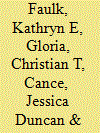

|
|
|
|
|
| Publication |
2012.
|
| Summary/Abstract |
Using the Broaden-and-Build Theory of Positive Emotions, the relationships among stress, positivity, and depressive symptoms were examined in a sample of military spouses during deployment (N = 367). Over one-third of the spouses reported moderately severe levels of depressive symptoms. After controlling for demographic and deployment variables, stress had a positive association with depressive symptoms (ß = .59, p < .001), while positivity had a negative association (ß = -.39, p < .001). Positivity was also found to play a moderating role on the relationship between stress and depressive symptoms (ß = -.29, p < .001). Spouses with lower positivity reported more depressive symptoms at both low and high levels of stress compared to those with higher positivity. The final model, including both direct and moderating variables, accounted for 69 percent of the total variance in depressive symptoms. Practical implications are discussed in terms of the importance of developing positivity in military spouses.
|
|
|
|
|
|
|
|
|
|
|
|
|
|
|
|
| 6 |
ID:
133294


|
|
|
|
|
| Publication |
2014.
|
| Summary/Abstract |
Large-scale deployment of low-carbon energy technologies is crucial to mitigating climate change, and public support is an important barrier to policies and projects that facilitate deployment. This paper provides insights to the origins of public opposition that can impede the adoption of low-carbon technologies by investigating how perceptions are shaped by local economic interests and individual cultural worldviews. The research considers both carbon capture and storage and wind energy technologies because they differ in maturity, economic impact and resource base. Further, for each technology, the research examines support for two types of policies: deployment in local community and public funding for research and development. Results indicate the influence of economic interests and cultural worldviews is policy specific. Individual cultural worldviews do not affect support for the deployment of technology, but they do significantly influence a person×s support for publicly funded research and development. Conversely, local economic interests have a significant role in determining support for deployment, while they do not affect support for research and development.
|
|
|
|
|
|
|
|
|
|
|
|
|
|
|
|
| 7 |
ID:
131048
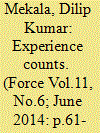

|
|
|
|
|
| Publication |
2014.
|
| Summary/Abstract |
One of the most uncomfortable questions that stare in the face of Appointments Committee of the Cabinet (ACC) is whether an IPS officer with a career-long experience in state police force can lead a central paramilitary force. Even within the central paramilitary forces, the tasks and objectives of the Central Reserve Police Force (CRPF) and the border guarding forces are different. Furthermore, among the border guarding forces, Indo-Tibetan Border Police Force (ITBP) functions differently than the Border Security Force (BSF) or the Sashastra Seema Bal (SSB) or Myanmar Border for that matter. So, shouldn't ACC consider the experience of the officer with a particular force before appointing him to its top position?
|
|
|
|
|
|
|
|
|
|
|
|
|
|
|
|
| 8 |
ID:
094817


|
|
|
|
|
| Publication |
2010.
|
| Summary/Abstract |
Studies on active duty military families indicate that deployment disrupts normal functioning of the family. Scholars still, however, lack the necessary knowledge to fully grasp the impact that the current Iraq and Afghanistan wars have had on Army National Guard (ARNG) families who have experienced deployment. A grounded theoretical approach to interviews with ARNG spouses yields insight into how these families are coping with the often-unexpected event of wartime deployment. The authors identify stressors and coping strategies used by these spouses and offer suggestions for future research that will allow scholars to more fully understand the present situation ARNG families are facing.
|
|
|
|
|
|
|
|
|
|
|
|
|
|
|
|
| 9 |
ID:
131728
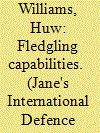

|
|
|
|
|
| Publication |
2014.
|
| Summary/Abstract |
Micro and nano UAVs are emerging as the latest link in the unmanned chain and are finding their niche on the modern battlefield. However how they will develop in future remains to be seen.
|
|
|
|
|
|
|
|
|
|
|
|
|
|
|
|
| 10 |
ID:
124631


|
|
|
|
|
| Publication |
2013.
|
| Summary/Abstract |
This paper argues that an integrated policy architecture consisting of multiple policy phases and economic instruments is needed to support the development of carbon capture and storage (CCS) from its present demonstration phase to full-scale deployment. Building on an analysis of the different types of policy instruments to correct market failures specific to CCS in its various stages of development, we suggest a way to combine these into an integrated policy architecture. This policy architecture adapts to the need of a maturing technology, meets the requirement of policymakers to maintain flexibility to respond to changing circumstances while providing investors with the policy certainty that is needed to encourage private sector investment. This combination of flexibility and predictability is achieved through the use of 'policy gateways' which explicitly define rules and criteria for when and how policy settings will change. Our findings extend to bioenergy-based CCS applications (BECCS), which could potentially achieve negative emissions. We argue that within a framework of correcting the carbon externality, the added environmental benefits of BECCS should be reflected in an extra incentive.
|
|
|
|
|
|
|
|
|
|
|
|
|
|
|
|
| 11 |
ID:
152321
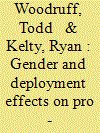

|
|
|
|
|
| Summary/Abstract |
This study examines whether gender moderates the relationships between deployment and both organizational identification and pro-organizational behaviors. The broader context motivating this study is the U.S. military’s 2016 rescission of the ground combat exclusion, accomplishing full gender integration in the armed forces. Structural equation modeling is used to test for gender moderation effects. Results reveal deployment frequency, but not current deployment, has small effects on several pro-organizational behaviors. Results also show that gender does not moderate the effects of deployment frequency on soldiers’ perceptions of the organization or economic or social satisfaction. Gender does moderate the effects of deployment frequency on soldiers’ identification with the army. Additionally, while gender was not found to moderate the relationship between combat deployments and overall pro-organizational behaviors among soldiers, it does moderate the effect of deployments on one pro-organizational item: sacrificing behavior. Implications are discussed with an eye toward full gender inclusion in the U.S. military.
|
|
|
|
|
|
|
|
|
|
|
|
|
|
|
|
| 12 |
ID:
186076
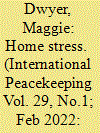

|
|
|
|
|
| Summary/Abstract |
Through the case of the Sierra Leonean deployment on the African Union Mission in Somalia (AMISOM), this study argues that family-related stress is an often-overlooked challenge in peacekeeping deployments. Using in-depth interviews with Sierra Leonean soldiers who were part of the deployment, military decision makers, and foreign advisors, this article lays out specific factors that created family-related tensions and contributed to lowered morale for Sierra Leonean peacekeepers. It demonstrates that the family-related stress on deployment is not only an issue of family separation, it is entangled with the historic trajectories of the armed forces and the sending country’s socio-economic conditions. The focus on Sierra Leone highlights the additional and unique burdens that soldiers and their families may endure in troop contributions from lower-income countries.
|
|
|
|
|
|
|
|
|
|
|
|
|
|
|
|
| 13 |
ID:
155824


|
|
|
|
|
| Summary/Abstract |
Children in military families experience various stressors associated with the demands of military life, such as parental absences due to deployments. However, there is a limited understanding of children’s well-being to parental deployment from Canadian military families. This study was conducted to examine the impact of deployment on the well-being of school age children from Canadian Armed Forces families and to consider the resilience factors in their well-being. Focus groups with children (N = 85) showed that deployment negatively impacted children’s well-being, routines, and family dynamics. Active distraction and social support seeking served as the most effective protective factors against deployment stress. Recommendations for mitigating the impact of deployment are offered.
|
|
|
|
|
|
|
|
|
|
|
|
|
|
|
|
| 14 |
ID:
133039
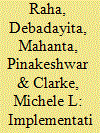

|
|
|
|
|
| Publication |
2014.
|
| Summary/Abstract |
The Indian Government's National Biogas and Manure Management Programme (NBMMP) seeks to deliver renewable energy services to households across the country by facilitating the deployment of family-sized (<6 m3) anaerobic (biogas) digesters. NBMMP policy is implemented at three levels, from government and state nodal agency, via private contractors to households, creating multiple institutional arrangements. We analysed the scheme in Assam, north-east India, focusing on how policy was implemented across two districts and interviewing stakeholders in rural households, state and non-state institutions. The top-down, supply-side approach to policy enables government to set targets and require individual states to deploy the scheme, which benefits households who can afford to participate. NBMMP delivered improved energy service outcomes to a majority of households, although the level of knowledge and understanding of the technology amongst users was limited. Training and education of householders, and particularly women, is needed in relation to the maintenance of digesters, feedstock suitability and the environmental and potential livelihood benefits of digestate. A revised bottom-up approach to policy, which highlights the contextual and demand-side issues around adopting the technology, may deliver monetary benefits from market competition and enable development of community-focused microfinance schemes to improve the affordability of biogas systems.
|
|
|
|
|
|
|
|
|
|
|
|
|
|
|
|
| 15 |
ID:
186344
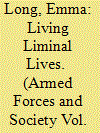

|
|
|
|
|
| Summary/Abstract |
The emotional cycle of deployment theorized by Logan and adapted by Pincus, House, Christenson, and Alder is often applied by academics and military support agencies to define, explain, and provide advice on the experiences and possible emotional reactions of military families during phases of deployment. Interviews with army partners showed that spatiotemporal experiences and perspectives are more complex than those afforded by the emotional cycle of deployment. This article argues that applying the concept of liminality uncovers some of this complexity, illuminating the in-between times experienced during deployments that are otherwise hidden. Army partners move through and between deployments and deployment phases haunted by specters of past and future deployments. By disrupting seemingly chronological and discrete spatiotemporal narratives, which often frame research on military families and deployment, this article demonstrates how army partners move through and between deployments and deployment stages negotiating past and future deployments. It shows how they continuously adapt and evolve practices while negotiating interpreted pasts and imagined futures in pursuit of becoming “ideal.”
|
|
|
|
|
|
|
|
|
|
|
|
|
|
|
|
| 16 |
ID:
116956


|
|
|
|
|
| Publication |
2012.
|
| Summary/Abstract |
Governments have attempted to advance alternative fuels (AFs) in the on-road transportation sector with the goal of addressing multiple environmental, energy security, economic growth, and technology transition objectives. However there is little agreement, at all governmental levels, on how to prioritize goals and how to measure progress towards goals. Literature suggests that a consistent, aligned, and prioritized approach will increase the effectiveness of deployment efforts. While literature states that goal alignment and prioritization should occur, there are few studies suggesting how to measure the alignment of deployment programs. This paper presents a methodology for measuring goal alignment by applying the theories of goal ambiguity. It then demonstrates this methodology within the context of fuel- and project-neutral (wide-scope) grant programs directed toward AF deployment. This paper analyzes forty-seven (47) wide-scope federal, state, and regional grant programs in the United States, active between 2006 and 2011. On the whole, governments most use deployment grant programs to address environmental concerns and are highly aligned in doing so between agency levels. In contrast, there is much less consensus (and therefore goal alignment) on whether or how governments should address other priorities such as energy security, economic growth, and technology transition.
|
|
|
|
|
|
|
|
|
|
|
|
|
|
|
|
| 17 |
ID:
098010
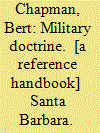

|
|
|
|
|
| Publication |
Santa Barbara, Praeger Security International, 2009.
|
| Description |
ix, 197p.
|
| Standard Number |
9780313352331, hbk
|
|
|
|
|
|
|
|
|
|
|
|
Copies: C:1/I:0,R:0,Q:0
Circulation
| Accession# | Call# | Current Location | Status | Policy | Location |
| 055143 | 355.033073/CHA 055143 | Main | On Shelf | General | |
|
|
|
|
| 18 |
ID:
114030


|
|
|
|
|
| Publication |
2012.
|
| Summary/Abstract |
The current military assignment policy of United States prohibits the assignment of females to billets with high risk of combat exposure. As part of an Army review of this policy, the authors analyzed deployment and promotion risk for combat medics. The effect of current policy on male deployment and female promotion risk was unknown. In light of other countries' policies and current operational considerations, senior military leaders sought to understand the effects of existing policy on a low-density, high-value occupational specialty, the combat medic. The authors found evidence that male medics deployed 2.07 times more frequently than female medics. The authors also found evidence that senior male medics (staff sergeants) deployed even more frequently (3.65-1) than their female counterparts. Perhaps as a result, the male combat medics experience higher likelihood of promotion from staff sergeant (E-6) to the rank of sergeant first class (E-7); however, the magnitude of that benefit was about one-third of the deployment risk. The results confirm the existence of gender-based deployment risk and promotion disparity. Based upon this analysis, the authors recommended the deprecation of current gender coding for combat medics to the senior levels of the US Army.
|
|
|
|
|
|
|
|
|
|
|
|
|
|
|
|
| 19 |
ID:
170308


|
|
|
|
|
| Summary/Abstract |
A fundamental question facing global governance today is whether the UN peacekeeping regime can function with enough skilled troops to execute increasingly demanding and complicated mandates. The People’s Republic of China is informally thought of as a potential lead troop-contributing country. China typically deploys non-combat enabler troops, and recently began deploying combat troops, which may have to engage in live fire to defend the mandate. The risks and costs associated with dispatching combat troops challenge the benefits that China derives from supporting peacekeeping. I first establish China’s feedback mechanisms to facilitate simple and complex learning against China’s peacekeeping trajectory and motivations for participation. I then address the implications of China’s combat troop deployment, focusing on the UN Multidimensional Stabilization Mission in Mali and the UN Mission in South Sudan. The article draws insights from interviews with Chinese foreign policy elites and UN officials, and participant observation at the UN Department of Peacekeeping Operations.
|
|
|
|
|
|
|
|
|
|
|
|
|
|
|
|
| 20 |
ID:
085368
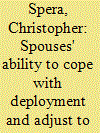

|
|
|
|
|
| Publication |
2009.
|
| Summary/Abstract |
Using data from 34,381 Air Force active-duty members, the current study examines active-duty members' perceptions of their spouse's or significant other's ability to cope with deployment of unknown length and adjust to demands of being an Air Force family. Active-duty members' perception of their spouse's ability to cope with deployment significantly varied by rank and time married, with 35 percent of junior enlisted and 30 percent of members married less than three years indicating their spouse would have a serious or very serious problem coping with deployment of unknown length. Protective factors-unit relationship quality, leadership effectiveness, and tangible social support from community members-were positively and significantly related to members' reports of spousal ability to adjust to Air Force family demands. The variance explained by these protective factors was highest for active-duty members who had been away from home for deployment or temporary duty for more than six months in the past twelve months.
|
|
|
|
|
|
|
|
|
|
|
|
|
|
|
|
|
|
|
|
|